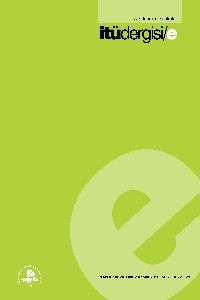Öz
Çevre Koruma Ajansı (EPA) tarafından öncelikli kirleticiler listesinde belirtilen 15 adet poliaromatik hidrokarbonun (PAH) petrokimya endüstrisi atıksularının aerobik sürekli karıştırmalı bir tank reaktörde (SKTR) arıtma verimliliğinin ve toksisitenin giderilmesi amaçlanmıştır. Ramnolipit biyosürfaktanının aerobik biyolojik arıtma verimi ile bazı kimyasal oksijen ihtiyacı
(KOİ) bileşenlerinin giderim verimine etkileri incelenmiştir. Aerobik SKTR sistemler 25 günlük çamur yaşında ve 5 günlük hidrolik bekleme sürelerinde işletilmiştir. Petrokimya endüstrisinden alınan atıksuyun ramnolipit (15mg/L) ilaveli SKTR reaktörde toplam PAH konsantrasyonu 65.36 ng/mL olup arıtılmış çıkış suyunda ise toplam PAH konsantrasyonu 8.76 ng/mL ve toplam PAH giderim verimi %87 olarak bulunmuştur. 3 benzen halkalı PAH’larda %74 ile % 99 arasında, 4 benzen halkalı PAH’larda (BaA hariç) %71 ile %79 arasında, 5 benzen halkalı PAH’larda %54 ile %74 ve 6 benzen halkalı PAH’larda ise %84 ile %87 arasında değişen giderim verimleri elde edilmiştir. Ramnolipit ilavesi inert KOİ giderim verimini %0’dan %60’a yükseltirken, yavaş ayrışabilen KOİ ve kolay ayrışabilen KOİ giderme verimlerini de sırası ile %2’den %74 ve %78’den %91’e çı-
karmıştır. Vibrio fischeri akut toksisite testinde organizmanın %50’sinin etkilendiği konsantrasyon (EC50) değerleri tespit edilmiştir. Giriş atıksuyunda sırası ile PAH ve KOİ baz alınarak hesaplanan EC50 değerleri 50.65 ng/mL ve 820 mg/L iken çıkış atıksuyunda 5.25 ng/mL ve 68.5 mg/L’ye azalmış olup PAH ve KOİ bazlı akut toksisite giderim verimleri sırasıyla %90 ve %92 olarak tespit edilmiştir.
Anahtar Kelimeler
Aerobik aktif çamur sistemi poloaromatik hidrokarbon (PAH) petrokimya ramnolipit toksisite
Destekleyen Kurum
Dokuz Eylül Üniversitesi BAP projesi
Proje Numarası
2007.KB.FEN.057
Teşekkür
PAH analizleri için yöntem oluşturmada ve ekstraksiyon işlemlerinde yardımcı olan sayın Prof. Dr. Mustafa Odabaşı ve Araş. Gör. Yetkin Dumanoğlu’na teşekkürlerimizi sunarız.
Kaynakça
- APHA-AWWA, (2005). Standard methods for the examination of water wastewater, 21st edition. American Public Health Association, Washington, DC.
- Bognolo, G., (1999). Biosurfactants as emulsifying agents for hydrocarbons, Physicochemical and Engineering Aspects, 152, 41-42.
- Busetti, F., Heitz, A., Cuomo, M., Badoer, S. ve Traverso, P., (2006). Determination of sixteen polycyclic aromatic hydrocarbons in aqueous and solid samples from an Italian wastewater treatment plant, Journal of ChromatographyA, 1102, 104-115.
- Das, P., Mukherjee, S. ve Sen, R., (2008). Improved bioavailability and biodegradation of a model polyaromatic hydrocarbon by a biosurfactant producing bacterium of marine origin, Chemosphere, 72, 1229-1234.
- DR LANGE, LUMISmini, (2009). Operating Manual, Dr.Bruno, Lange, Düsseldorf, Germany.
- Ekama, G.A., Dold, P.L. ve Marais, G.R., (1986). Procedures for determining influent COD fractions and the maximum specific growth rate of heterotrophs in activated sludge systems, Water Science Technology, 18, 91-114.
- Germirli, F., İnce, O., Orhon, D. ve Şimşek, A., (1998). Assessment of inert COD in pulp and paper mill wastewater under anaerobik conditions, Water Research, 32, 3490-3494.
- Germirli, F., Orhon D. ve Artan, N., (1991). Assessment of the initial inert soluble COD in industrial wastewater, Water Science Technology, 23, 1077-1086.
- Girotti, S., Ferri, E.N., Fumo, M.G. ve Maiolini, E., (2008). Monitoring of environmental pollutants by bioluminescent bacteria, Analytica Chimica Acta, 608, 2-29.
- Kanaly, R.A. ve Harayama, S., (2000). Biodegradation of high molecular weight polycyclic aromatic haydrocarbons by bacteria, Journal of Bacteriology, 182, 2059-2067.
- Katsoyiannis, A. ve Samara, C., (2007). Ecotoxicological evaluation of the wastewater treatment process of the sewage treatment plant of Thessaloniki, Greece. Journal of Hazardous Materials, 141, 614-621.
- Kolomytseva, M.P., Randazzo, D., Baskunov, B.P.,Scozzafava, A., Briganti, F. ve Golovleva, L.A., (2009). Role of surfactants in optimizing fluorene assimilation and intermediate formation by Rhodococcus rhodochrous VKM B-2469, Bioresource Technology, 100, 839-844.
- Kosaric, N., (2001). Biosurfactants and their application for soil bioremedation, Food Technology and Biotechnology, 39, 295-304.
- Ma, F., Guo, J., Zhao, L.J., Chang, C.C. ve Cui, D., (2009). Application of bioaugmentation to improve the activated sludge system into the contact oxidation system treating petrochemical wastewater, Bioresource Technology, 100, 597-602.
- Mulligan, C.N., Yong, R.N. ve Gibbs, B.F., (2001). Surfactant-enhanced remediation of contaminated soil: a review, Engineering Geology, 60, 371-380.
- Pathak, H., Kantharia, D., Malpani, A. ve Madamwar, D., (2009). Naphthalene degradation by Pseudomonas sp. HOB1: in vitro studies and assessment of naphthalene degradation efficiency in simulated microcosms, Journal of Hazardous Materials, 166, 1466-1473.
- Randhır, S.M. ve Rockne K.J., (2003). Comparison of synthetic surfactants and biosurfactants in enhancing biodegradation of polycyclic aromatic hydrocarbons, Environmental Toxicology and Chemistry, 22, 10, 2280-2292.
- Santos, E.C., Jacques, R.J.S., Bento, F.M., Peralba, C.M.C.R., Selbach, P.A., Sa´, E.L.S. ve Camargo, F.A.O., (2008). Anthracene biodegradation and surface activity by an iron-stimulated Pseudomonas sp., Bioresource Technology, 99, 2644-2649.
- Sponza, D.T. ve Gök, O., (2009). Petrokimya endüstrisi atıksularında PAH ve toksisite giderimine çamur yaşının etkisi, Türkiye’de Çevre Kirlenmesi Öncelikleri Sempozyumu VI, GYTE Kocaeli Türkiye, 27-32.
- Sartoros, C., Yerushalmi, L., Beron, P. ve Guiot, S.R., (2005). Effects of surfactant and temperature on biotransformation kinetics of anthracene and pyrene, Chemosphere, 61, 1042-1050.
- Trably, E. ve Patureau, D., (2007). Successful treatment of low PAH-contaminated sewage sludge in aerobic bioreactors, Environmental Science Pollution Research, 13, 170-176.
- U.S. Environmental Protection Agency, (2002). Integrated risk information system (IRIS), Office of Research and Development, National Center for Environmental Assessment, Washington, DC.
- Whang, L.M., Liu, P.G., Ma, C. ve Cheng, S., (2008). Application of biosurfactants, rhamnolipid, and surfactin, or enhanced biodegradation of diesel contaminated water and soil, Journal of Hazardous Materials, 151, 155-163.
- Zhao, X., Wang, Y., Ye, Z., Borthwick, A.G.L. ve Ni, J., (2006). Oil field wastewater in biological aerated filter by immobilized microorganisms, Process Biochemistry, 41, 1475-1483.
- http://www.petkim.com.tr/Petkim/index.jsp?git=petrokimya&go=23, (15.10.2009).
Ayrıntılar
| Birincil Dil | Türkçe |
|---|---|
| Konular | Su Kaynakları ve Su Yapıları |
| Bölüm | Araştırma makaleleri |
| Yazarlar | |
| Proje Numarası | 2007.KB.FEN.057 |
| Yayımlanma Tarihi | 31 Aralık 2010 |
| Yayımlandığı Sayı | Yıl 2010 Cilt: 20 Sayı: 2 |


